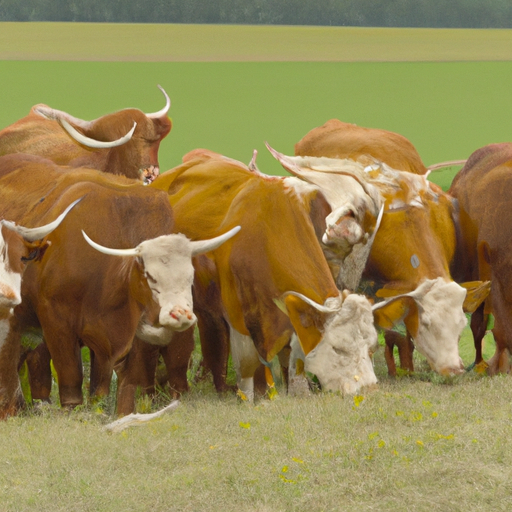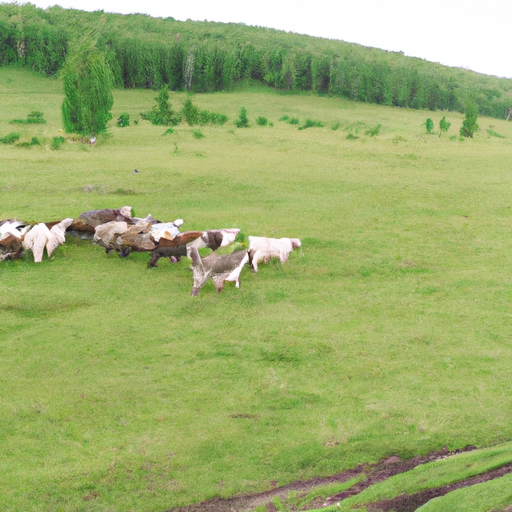
The Importance of Proper Cattle Handling Techniques
Raising beef cattle is a complex and rewarding endeavor that requires careful attention to detail and a deep understanding of proper cattle handling techniques. These techniques are crucial for the well-being of the animals, as well as for the success of the operation as a whole. In this article, we will explore the importance of proper cattle handling techniques and how they can contribute to the overall health and productivity of the herd.
One of the primary reasons why proper cattle handling techniques are so important is because they can help reduce stress and anxiety in the animals. Cattle are highly sensitive creatures, and any unnecessary stress can have a significant impact on their overall health and well-being. By using gentle and calm handling techniques, farmers can create a low-stress environment for their cattle, which can lead to improved weight gain, better reproductive performance, and reduced risk of disease.
In addition to reducing stress, proper cattle handling techniques can also help prevent injuries to both the animals and the farmers themselves. Cattle can be unpredictable and potentially dangerous, especially when they feel threatened or cornered. By using techniques such as low-stress herding and proper chute design, farmers can minimize the risk of accidents and injuries during handling procedures. This not only protects the animals but also ensures the safety of the farmers and their employees.
Furthermore, proper cattle handling techniques can have a positive impact on the quality of the meat produced. When cattle are handled with care and respect, they are less likely to experience bruising or other physical injuries that can affect the quality of the meat. Additionally, low-stress handling techniques can help reduce the release of stress hormones in the animals, which can lead to improved meat tenderness and flavor. By prioritizing proper handling techniques, farmers can ensure that their beef is of the highest quality, which can ultimately lead to increased customer satisfaction and repeat business.
Implementing proper cattle handling techniques requires a combination of knowledge, skill, and patience. Farmers must be familiar with the natural behavior of cattle and understand how to work with their instincts rather than against them. They must also be able to read the body language of the animals and respond accordingly, using techniques such as pressure and release to guide the cattle in the desired direction. Additionally, farmers must invest in the necessary infrastructure and equipment, such as well-designed chutes and handling facilities, to facilitate safe and efficient handling procedures.
In conclusion, proper cattle handling techniques are of utmost importance in the raising of beef cattle. They not only contribute to the overall well-being and productivity of the animals but also have a direct impact on the quality of the meat produced. By reducing stress, preventing injuries, and ensuring the highest standards of care, farmers can create a positive and sustainable environment for their cattle. This, in turn, can lead to improved profitability and success in the beef cattle industry.
Essential Factors to Consider in Cattle Nutrition and Feeding

Raising beef cattle is a complex and rewarding endeavor that requires careful consideration of various factors. One of the most crucial aspects of cattle management is nutrition and feeding. Providing the right diet for your cattle is essential for their growth, health, and overall productivity. In this section, we will discuss some essential factors to consider when it comes to cattle nutrition and feeding.
First and foremost, it is important to understand the nutritional requirements of beef cattle at different stages of their life. Calves, growing cattle, and mature cows all have different nutritional needs, and it is crucial to provide them with the appropriate diet for optimal growth and development. A balanced diet should include a combination of energy, protein, minerals, and vitamins.
Energy is a vital component of a cow’s diet as it provides the fuel for growth, reproduction, and maintenance. The main source of energy for cattle is carbohydrates, which can be obtained from forages such as grass and hay, as well as grains like corn and barley. It is important to ensure that the energy content of the diet matches the animal’s requirements to prevent undernourishment or excessive weight gain.
Protein is another essential nutrient for beef cattle, as it is necessary for muscle development, milk production, and overall health. Protein can be obtained from both plant and animal sources, such as soybean meal, cottonseed meal, and fishmeal. It is important to provide a balanced protein source that meets the animal’s requirements to promote optimal growth and performance.
Minerals and vitamins are also crucial for cattle health and productivity. Minerals such as calcium, phosphorus, and magnesium are necessary for bone development, milk production, and overall metabolic functions. Vitamins, on the other hand, play a vital role in various physiological processes, including immune function and reproduction. It is important to provide a mineral and vitamin supplement to ensure that the cattle’s requirements are met, especially if they are grazing on mineral-deficient pastures.
In addition to understanding the nutritional requirements of beef cattle, it is also important to consider the feeding management practices. Feeding methods can vary depending on the size of the operation, available resources, and management goals. Some common feeding methods include pasture grazing, hay feeding, and total mixed ration (TMR) feeding.
Pasture grazing is a traditional and cost-effective method of feeding cattle, especially during the grazing season. It allows cattle to consume fresh forages, which provide a good source of energy and nutrients. However, it is important to manage grazing properly to prevent overgrazing and ensure that the pasture is of high quality.
Hay feeding is another common feeding method, especially during the winter months when fresh forages are not available. It is important to provide good quality hay that meets the nutritional requirements of the cattle. Proper storage and handling of hay are also crucial to prevent spoilage and nutrient loss.
Total mixed ration (TMR) feeding is a more intensive feeding method that involves formulating a complete diet that includes all the necessary nutrients. This method allows for precise control of the diet and can be particularly useful for intensive production systems. However, it requires careful formulation and management to ensure that the diet is balanced and meets the animal’s requirements.
In conclusion, nutrition and feeding are essential factors to consider in raising beef cattle. Understanding the nutritional requirements of cattle at different stages of their life and providing a balanced diet is crucial for their growth, health, and productivity. Additionally, choosing the appropriate feeding method and managing it properly can contribute to the overall success of the operation. By considering these factors, cattle producers can ensure that their cows are well-nourished and thriving.
Effective Strategies for Managing Cattle Health and Disease
Raising beef cattle is a complex and rewarding endeavor that requires careful attention to the health and well-being of the animals. Effective strategies for managing cattle health and disease are essential for ensuring the success of any beef cattle operation.
One of the most important aspects of managing cattle health is implementing a comprehensive vaccination program. Vaccinations are crucial for preventing and controlling common diseases that can affect cattle, such as respiratory and reproductive diseases. It is important to work closely with a veterinarian to develop a vaccination schedule that is tailored to the specific needs of the herd.
In addition to vaccinations, regular health checks are essential for identifying and addressing any potential health issues before they become more serious. This includes monitoring the body condition of the cattle, checking for signs of illness or injury, and conducting routine tests for common diseases. Early detection and treatment can significantly improve the chances of a successful recovery and minimize the spread of disease within the herd.
Proper nutrition is another key factor in maintaining the health of beef cattle. A well-balanced diet that meets the nutritional needs of the animals is essential for their overall health and productivity. This includes providing access to clean and fresh water, as well as a diet that is rich in essential nutrients, such as protein, carbohydrates, and minerals. It is important to work with a nutritionist or veterinarian to develop a feeding program that is appropriate for the specific needs of the herd.
Maintaining a clean and sanitary environment is also crucial for preventing the spread of disease among cattle. Regular cleaning and disinfection of barns, feeders, and water troughs can help reduce the risk of bacterial and viral infections. It is also important to practice good biosecurity measures, such as limiting the movement of animals and people between different areas of the farm, to prevent the introduction and spread of diseases.
Another effective strategy for managing cattle health is implementing a proper herd health management plan. This includes keeping detailed records of vaccinations, health checks, and treatments, as well as monitoring the overall health and performance of the herd. Regularly reviewing these records can help identify any patterns or trends that may indicate potential health issues and allow for timely intervention.
In addition to these strategies, it is important to be proactive in preventing and controlling the spread of diseases. This includes implementing a quarantine period for new animals to ensure they are free from any contagious diseases before introducing them to the herd. It is also important to practice good biosecurity measures when attending livestock shows or sales, as these events can be potential sources of disease transmission.
In conclusion, effective strategies for managing cattle health and disease are essential for the success of any beef cattle operation. This includes implementing a comprehensive vaccination program, conducting regular health checks, providing a well-balanced diet, maintaining a clean and sanitary environment, and implementing a proper herd health management plan. By following these strategies, cattle producers can help ensure the health and well-being of their animals, as well as the overall success of their operation.






